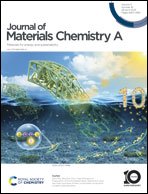Hydrogen in disordered titania: connecting local chemistry, structure, and stoichiometry through accelerated exploration†
Abstract
Hydrogen incorporation in native surface oxides of metal alloys often controls the onset of metal hydriding, with implications for materials corrosion and hydrogen storage. A key representative example is titania, which forms as a passivating layer on a variety of titanium alloys for structural and functional applications. These oxides tend to be structurally diverse, featuring polymorphic phases, grain boundaries, and amorphous regions that generate a disparate set of unique local environments for hydrogen. Here, we introduce a workflow that can efficiently and accurately navigate this complexity. First, a machine learning force field, trained on ab initio molecular dynamics simulations, was used to generate amorphous configurations. Density functional theory calculations were then performed on these structures to identify local oxygen environments, which were compared against experimental observations. Second, to classify subtle differences across the disordered configuration space, we employ a graph-based sampling procedure. Finally, local hydrogen binding energies and hopping kinetics are computed using exhaustive density functional theory calculations on representative configurations. We leverage this methodology to show that hydrogen binding energetics are described by local oxygen coordination, which in turn is affected by stoichiometry, and form the basis of hopping kinetics and diffusion. Together these results imply that hydrogen incorporation and transport in TiOx can be tailored through compositional engineering, with implications for improving the performance and durability of titanium-derived alloys in hydrogen environments.

- This article is part of the themed collection: #MyFirstJMCA


 Please wait while we load your content...
Please wait while we load your content...